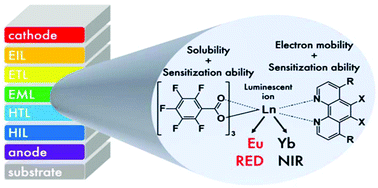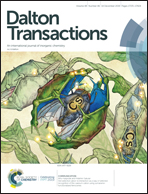On the development of a new approach to the design of lanthanide-based materials for solution-processed OLEDs†
Abstract
The targeted design of lanthanide-based emitters for solution-processed organic light-emitting diodes (OLEDs) resulted in obtaining an NIR OLED with one of the highest efficiencies among ytterbium-based solution-processed OLEDs (30 μW W−1). The design was aimed at the combination of high luminescence efficiency with solubility and charge carrier mobility. The latter was achieved thanks to the introduction of the purposefully selected neutral ligands, which combine electron mobility and the ability to sensitize lanthanide luminescence. Besides, the HOMO and LUMO energies and charge carrier mobility of solution-processed thin films of coordination compounds were measured experimentally for the first time, and novel highly luminescent europium-based materials with PLQYs of up to 80% and purely NIR luminescent ytterbium complexes were obtained.



 Please wait while we load your content...
Please wait while we load your content...